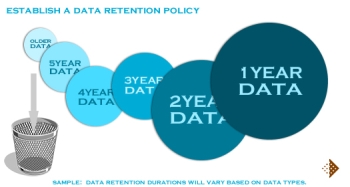 A data retention policy helps determine what data you keep, where you keep it and for how long. During a time when you can purchase a laptop that contains a 500GB hard drive or store your data in the cloud for as little as $20 for 200GB, you may not see the necessity to develop a policy. But picture this: You need a document that you typed two or three years ago. Did you send it in an email? Did you have the same computer at the time? Is it on external hard drive? Is it stored on your Google Docs account? Without developing a data retention policy, looking for that file could end up costing a great deal of time—at least! But where should you begin?
A data retention policy helps determine what data you keep, where you keep it and for how long. During a time when you can purchase a laptop that contains a 500GB hard drive or store your data in the cloud for as little as $20 for 200GB, you may not see the necessity to develop a policy. But picture this: You need a document that you typed two or three years ago. Did you send it in an email? Did you have the same computer at the time? Is it on external hard drive? Is it stored on your Google Docs account? Without developing a data retention policy, looking for that file could end up costing a great deal of time—at least! But where should you begin?
Give it Some Thought
What is driving your need for a data retention policy? Create a statement that will guide you on this journey. Some examples: “I need to spend less on data storage” or “I need to be able to put my hands on my data quickly”. Statements like these will be useful when making a decision about what to do with your data.
It is also important at the outset, to involve anyone that needs to access the data. Gather information about their location, internet accessibility and any needs they have. This may change your direction, and this is OK. Often, you will find that much of your data is being kept for others and that discovery could give you some insight when looking for solutions later on.
Create a Map
Create a chart of the types of data you have and how long it should be kept. This should be driven by your business, legal or personal requirements to have the data available. You should use this time to gather info like where your data is located and the cost of storage. Consider what can be moved to the cloud and what needs to stay closer to home. If your data is sprinkled across a network, take note of its location and who else has access to these files. Try consolidating the data to locations that make sense based on who needs to access it. While going through your files, you can also start deleting files that are older than your determined threshold or otherwise useless.
Develop your Policy
Using the map you’ve made, begin to develop your policy. Your policy should include the types of data you’ll apply it to, the length of time for which you will keep it and the method and location of storage.
Look for Tools
There is no single tool that will meet all of your needs. However, there are some inexpensive or free tool to help manage your disk spaces and files. If your are using third party tools for storing your data, it is important to know the retention policies of those services as well.
Test your Policy
If your data retention policy is ready for use, try it out for a while. Don’t be afraid to tweak the policy where it needs it. This process is fluid and will take quite a few changes over time. Once you have reached a place where all the bumps have been ironed out, it is time to set a schedule. Inform all of your invested parties about the policy and when data will move into and out of archives.
In Conclusion
It is important to keep an eye on your data. With the price of data storage lowering, it is tempting to continue sprawling without giving much thought to cost or location. However, the organization of your files will result in greater efficiency. The policy will also lead you directly to your old files as well as help you to know when it’s time to delete them.
